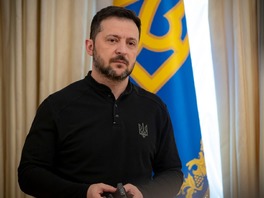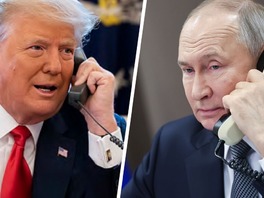A decade ago, the Kremlin initiated a military maneuver in Crimea, aiming to control Ukraine by establishing ‘people's republics.’ ‘Little green men," unidentified Russian troops, surfaced on February 20, 2014, orchestrating a dubious ‘referendum.’ Initially planning a puppet ‘state’ in Crimea, the idea of ‘joining’ emerged later when Moscow sensed Western tolerance for overt occupation. The Kremlin hesitated due to the lack of widespread pro-Russian sentiment in Crimea. Explore the details in the Apostrophe article.
There was another plan
Russia's enduring strategic objective, reclaiming control over Ukraine, has persisted for over two decades. While initially pursuing political means to neutralize Ukrainian statehood, the Kremlin shifted to forceful methods in February 2014. The significance of Moscow's interest in Crimea became apparent with the ‘Kharkiv Pact’ signed by the then president of Ukraine Viktor Yanukovych with the then President of the Russian Federation Dmitry Medvedev in 2010. The document extended the Russian fleet's presence in Sevastopol until 2042, as highlighted by military expert Ivan Stupak in his commentary Apostrophe.
‘Subsequently, the Kremlin, represented by Vladislav Surkov, promoted an idea to build a bridge across the Kerch Strait—a project abandoned during the USSR due to numerous challenges -not solely economic. There existed a political objective of creeping integration of the Crimean peninsula -economical and later political - with Russian regions. If Yanukovych had retained power, Moscow would probably have pressured him to 'lease’ Crimea for a century, extendable, in exchange for gas discounts. This strategy mirrored the earlier extension of the Russian Black Sea Fleet ultimately lease, which later would have result in the transfer of the entire peninsula’, Stupak says.
Throughout the decade of the peninsula's occupation, Kremlin propaganda has consistently obscured the most unpleasant fact for the dictator Putin: at the onset of the ‘little green men’ invasion, there was a lack of widespread pro-Russian sentiment and the inclination to join the Russian Federation in Crimea.
The local populace served as silent passive spectators and pawns, shaping the desired narrative for Kremlin propaganda. Nevertheless, during the years of Ukrainian independence, Russian agents never managed to establish a dependable separatist movement, which is why the Kremlin had to use brute force.
In February 2014, Russia launched an operation to annex Crimea under the guise of an illicit "referendum." Over the past decade, the Crimean population has endured systematic and intense propaganda efforts aimed at concealing the true motives behind Vladimir Putin's Kremlin decision to seize the peninsula, as well as the reasons why the local authorities, although not without resistance, took part in this adventure.
In January-February 2014, amid heightened protests against Viktor Yanukovych's regime on the Euromaidan, Crimea residents, as per Simferopol citizens' accounts, maintained their usual routines. Regional media, influenced by the "Party of Regions," focused less on opposing the participants of the Revolution of Dignity and more on supporting the existing Yanukovych and his ‘young reformers’ government, marked by corruption and the illicit appropriation of business from successful entrepreneurs across Ukraine. References to Ukrainian ‘Nazis’,
later evolved into a central narrative in Kremlin propaganda, were predominantly found in the controversial ‘Crimean Truth,’ mainly read by pro-Soviet pensioners.
Without the support of Crimeans
Putin and his inner circle opted for the deployment of "little green men" knowing that the Crimean public wouldn't initiate action without external intervention. Directly involved in the MH17 disaster, Russian special services operative and terrorist Igor Girkin played a significant role in the ‘Russian Spring’ of 2014, attempting to capture Ukrainian cities and topple the legitimate Ukrainian government in the south and east of Ukraine. Girkin later acknowledged the absence of widespread support for the occupiers' actions on the peninsula.
He also detailed how, alongside other Russian saboteurs, he coerced members of the Verkhovna Rada of Crimea into voting for the initiation of a ‘referendum’ on the region's status.
Serhiy Aksyonov, а criminal figure and extortionist, waslater appointed as the occupying ‘head of Crimea.’
‘Initially Aksyonov remained in the dark, as he doubted Moscow's support for the so-called ‘Crimean uprising.’ Anatoliy Mohylyov, then head of the Council of Ministers of the Autonomous Republic of Crimea, acknowledged the new government in Kyiv formed by the political leaders of the Revolution of Dignity following Yanukovych's departure from his presidential residence Mezhyhirya. The Crimean Militia, internal troops, SBU, and the Prosecutor's Office were either prepared for clearing the premises from pro-Russian insurgents or adopted a wait-and-see approach. There was even option to engage special forces of Directorate for Combating Organized Crime but there were no specific instructions from Kyiv, allowing the Russians to exploit the situation,’ Pavlo D., employed in the office of the Council of Ministers of Crimea during the occupation, remind to Apostrophe.
Most politically engaged Crimean residents showed no interest in joining the Russian Federation, as reflected in the fall 2012 Verkhovna Rada elections. The Party of Regions, aligned with President Yanukovych and promoting pro-Russian sentiments, secured 52.34% of the vote. The pro-Russian Communist Party of Ukraine garnered 19.41%, while 'Batkivshchyna,’ associated with then jailed former Ukrainian PM Yulia Tymoshenko, received 13.09%. UDAR, linked to Vitaliy Klitschko, and the nationalist 'Svoboda’ obtained 7.17% and 1.04%, respectively. In Sevastopol, ‘regionals’ had 46.9% support, communists - 29.46%, ‘Batkivshchyna’ - 5.86%, and UDAR and ‘Svoboda’ - 5.04% and 1.37%.
The Communist Party of Ukraine was aligning with pro-Russian sentiments and supporting Yanukovych's politics, while ‘Batkivshchyna’ traditionally focuses on the lower-middle class, pensioners, and housewives, appealing to lower social standards in Ukraine.
Pro-Soviet sentiments dominated the region, particularly among pensioners who favored the Communists or Natalya Vitrenko's Progressive Socialist Party of Ukraine.
Both pro-Soviet and Ukrainian national-democratic movements enjoyed approximately 20-25% support each. The predominant advocates for reunification with Russia during the orchestrated ‘referendum’ a decade ago were pensioners. Such proponents of the ideas of great and powerful Russia, believing that Russia could offer them a superior life, actively and voluntarily participated in the vote for the annexation of the Crimea. For now, many of them, due to age and illness, have since passed away. Yet, the Kremlin artificially sustains the measure of 'patriotic sentiments’ by relocating residents from other Russian regions to the peninsula, as pointed out by Crimean political scientist Yevhenia Horyunova in a discussion with Apostrophe.
‘Similar to that time, around 50-60% of Crimeans constitute a political 'swamp.' The primary motivation behind their acceptance of the occupation is economic. They aspired to receive 'higher' Russian salaries, momentarily overlooking the cost of living. The promoted Russian social package served as their incentive, but economic realities turned out to be a considerable letdown. Over the past 10 years, disillusionment has only intensified. While their affinity for Ukraine may not have increased, this segment of the population has gained a clearer understanding of Russia. Consequently, it appears highly doubtful that this 'swamp' will resist the Ukrainian army during the deoccupation process,’ Horyunova said.
Reasons for Putin's full-scale invasion
In 2014, the ‘Russian Unity’ party, under the leadership of the current Kremlin-appointed ‘head of Crimea,’ Serhiy Aksyonov, held a mere three out of a hundred mandates in the regional parliament, placing it at the periphery of political influenceand it was actually on the margins.
In early 2014, there was such a small number of people in Crimea ready to oppose the Ukrainian government, that recruitment of participants from Russia, termed "Putin’s tourists," to fabricate the illusion of widespread protests. The orchestration of the March 2014 ‘referendum’ and the quashing of opposition primarily involved the Russian military, Russian ‘Cossacks,’ and local criminals targeting pro-Ukrainian residents and journalists.
The 'Krymnash' operation, ('the Crimea is our', a key moto in Kremlin propaganda during the initial years of the occupation) temporarily boosted the Russian dictator's approval rating to a formal 85%, but it gradually declined over the years. Despite Moscow's failed efforts to legitimize the Crimea occupation and exploit temporarily occupied territories in Donbas as a strategic advantage against Kyiv, Putin's standing weakened. The occupation, initially intended to trigger the collapse of Ukrainian statehood, failed to yield significant military and political gains for Moscow. This, in part, led to Putin's decision to initiate a full-scale invasion in February 2022, a move that, despite substantial sacrifices, appears poised to end in another setback for the aging Kremlin leader. The unwavering determination to retain Crimea at any cost may ultimately prove to be Putin's downfall.





